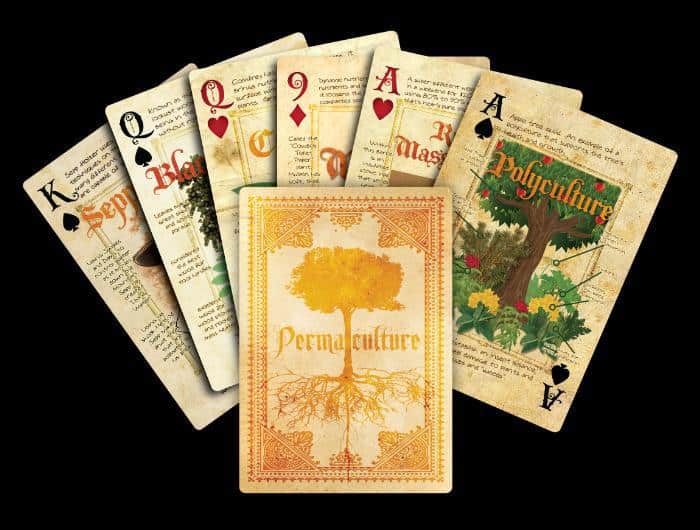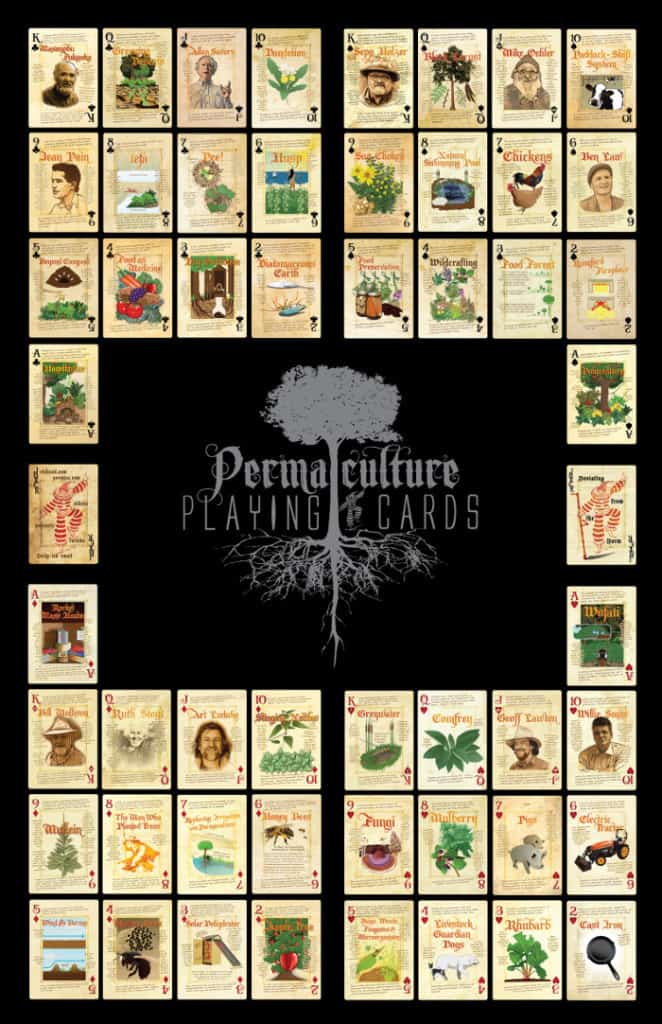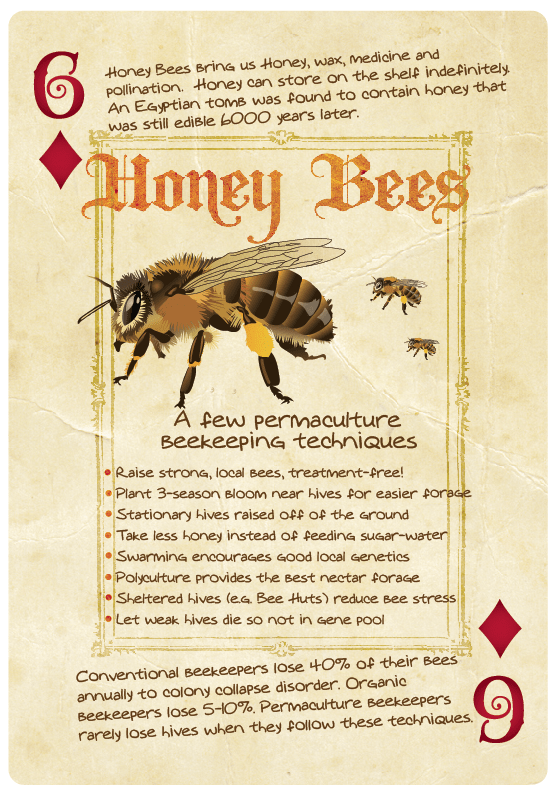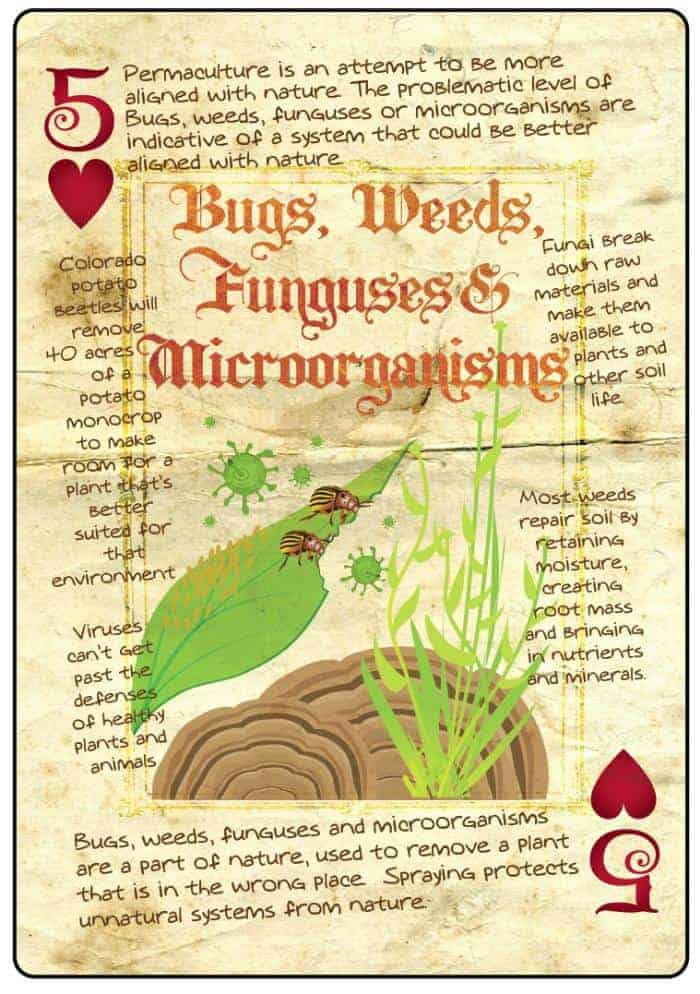Periodically there are advantages to being a blogger.
I fell in love with these stunning Permaculture Playing Cards and was about to buy myself a pack on Amazon when I remembered that I knew the guy who made them.

So I emailed Paul Wheaton, the founder of Permies.com, and said, “Hey, before I buy these gorgeous Permaculture Cards, you wouldn’t have an extra deck kicking around you’d wanna send me as a review copy? Wouldja, wouldja?”
I hear back from him: “Twelve decks will be to you on Tuesday.” (Paul is like seven feet tall and sometimes I think that makes him want to go bigger with everything he does.)
“What the hell, Paul? I mean, a huge thank you, but I don’t really need a dozen decks of cards!”
“So give some away if you want.”
And so here we are. I’m keeping two decks for myself, which leaves ten decks of Permaculture Playing Cards to give away, courtesy of Permies.com.
Perma-wha?
You’ve heard of Permaculture, surely. This work-with-nature, systems-design-approach to growing (and, according to some practitioners, life), is working its way towards mainstream.
Thanks to books like Gaia’s Garden and The Vegetable Gardener’s Guide to Permaculture and the popularly of practical, accessible techniques like hugelkultur and keyhole gardens, more and more gardeners are incorporating aspects of permaculture in their garden.
I, myself, am Perma-curious. My garden is not designed top-to-bottom according to permaculture principles but as I find out how effective the practical techniques are, I move in that direction.
And that’s where these Permaculture Playing Cards come in. The deck of cards is a whimsical way to make “bite-sized” bits of permaculture accessible to people who aren’t quite ready to commit to, say, the 500+ pages of intense study required by Permaculture: A Designers’ Manual.

The cards are stunningly beautiful. I know I keep harping on that, but for real – the artwork and design is simply inspired. The cardstock is thick and will wear well and the size is nice for holding.
Each card has something notably important to Permaculture on it: key people, techniques, plants, animal husbandry techniques and more. Surrounding the image on each card are little facts about that Permaculture concept. It’s just enough to suck you in and make you want to read your deck of cards and go on and learn more, but not so much that the cards become unusable as actual playing cards.

Oh yeah – did I mention you can actually play poker with ’em? Cool.
I think these things are great on multiple levels – as art, as education, as subtle propaganda for a better world. Highly recommended as a gift for your favorite Perma-curious or Perma-fanatic people.

Enter To Win A Deck of Permaculture Playing Cards
To enter to win one deck of Permaculture Playing Cards leave a comment on this blog post telling me what you like most about Permaculture, or (if the whole concept is a bit new to you) what about Permaculture you are most interested in learning.
Ten winners will be selected at random. Contest closes this Saturday, December 14th, at 6 pm PST so that I can mail the cards out to the winners next Monday. If you are a winner you will be notified be email. You have 24 hours to claim your prize. Sorry to be so strict but we are on a holiday timeframe here. Contest open to addresses in the United States only due to shipping. Sorry international readers.
Good luck!
Related Permaculture Stuff…
Permies.com – Huge resource for Permaculture enthusiasts. The forums are extensive, helpful and well-moderated so they stay that way. For more info on the Permaculture Playing Cards, check out this thread on Permies.
Half-Assed Hugelkultur – my post on attempting this funny-sounding Permaculture garden-bed-building technique. Foot-for-foot my hugels typically out-produce my traditional beds with watering four-six times a summer.
Permaculture Playing Cards on Amazon.com – Check out reviews, see what other people have to say.
The Vegetable Gardener’s Guide to Permaculture: Creating an Edible Ecosystem, by Christopher Shein – A fairly recent release focusing on Permaculture basics and how to apply the Permaculture concepts to a more traditional garden. I particularly recommend this book to beginning urban Permaculturists. It has great design and a modern layout.
Gaia’s Garden: A Guide to Home-Scale Permaculture, by Toby Hemenway – a slightly more technical, but still very accessible look at Permaculture at the gardener’s scale.
Permaculture: A Designers’ Manual, by Bill Mollison – for the hard core student of Permaculture. This is considered the classic text of Permaculture, but I wouldn’t personally recommend it as your first text on the subject unless you are pretty NerdCore about gardening.
All images in this post courtesy Paul Wheaton / Permies.com.
0
my favorite thing – produce no waste. there are many self regulating properties in permaculture, but this one appeals to me the most.
Permaculture is new to me, but my absolute goal is to grow food to feed my family, so definitely how to do that is the most interesting concept.
This is a test comment. I want to make sure it works. But I will say this permaculture is great.
Love the art on these cards and would love to learn more. Would love to do more plantings for the bees!
This is another test comment.
This is new to me. I am in the exploring/learning phase.
your blog is a refreshing oasis in the sea of mediocre blogs. permaculture is just one way of integrating growing. i love both!
using small & slow solutions.
sustainability has to start somewhere. even the smallest step from growing your own herbs, veggies or composting is a start! <3
The forests of the world work on permaculture and I love forests!
Plant for all the pollinators: http://www.polinators.org.
Wow, those cards are gorgeous!!! The thing i like most about permaculture is that its not a list of set actions, it’s a way of thinking that allows you to see the greater picture in every micro decision, and how they add up to create your existence. A universal framework for living!
Perma-newbie here, but Rocket Mass Heaters were the hook for me. Love the systems approach and downright efficiency of permaculture haibts. Looking forward to learning more!
I’d love to enter this drawing! I really know nothing about permaculture but have heard the term often. I’d like to move “beyond organic” in the garden. Thanks for holding the drawing!
I am interested in gardens that require less maintenance (I’m lazy!). Permaculture seems to offer a more labor up front and then sustain concept, which appeals to me. The cards are so pretty!
Permaculture brings us together as a family – our survival depends on caring for the earth. My husband is willing to try anything in our .18 acre yard and shares his successes with others – you should see the evolving keyholes in our garden, the fruit trees and incredible repurposing going on!
Oooooh, PRETTY! *drool*
It’s a lot easier to work with MOM (Mother Earth) than against her. She always gets her way in the end anyway. But through permaculture practices, it’s nice to find out that she’s open to suggestions.
One of my favorite concepts of permaculture is the idea of zones. I often counsel my clients to put their gardens as close to their house as possible. If it’s right out your back or front door you will be more likely to interact with it on a daily basis (re: pulling weeds!). I have seen this idea in action since I have a backyard garden that gets a lot of attention and a community garden plot within walking distance that often feels so far away and doesn’t get as much love.
Perma culture looks overwhelming, any way to do it in little bits?
My husband got so excited about these cards even HE wrote a comment!! We’ve just begun to learn a little about permaculture and strive to use natures example as our guide in our quest to become more self sustainable. Go earth!
I’m so glad you’re giving more publicity to permaculture. What I like best about permaculture is that it teaches us that we can live abundantly by partnering with Nature. And, the more permaculture you do, the less work you end up with in the long run. I’d love some of these beautiful cards and would love to give them to everyone I know!
Love the cards, beautifull to keep handy for my kids to read and learn.
I don’t know about permaculture, but the little I know, is that it’s doing things in tune with nature, as nature intended. I have had a small garden for several years, slowly growing and untuitively moving towards this natural, organic ways. I definitely need to learn more to grow in a smart direction, with this purpose.
Awesome giveaway! Rainwater harvesting is one of the most intriguing and useful aspects of permaculture, especially if you live in an arid environment. I also love the concept of recreating natural plant ad soil layers in the environment. Thanks!
I appreciate the fact that permaculture is a complete system; it covers all aspects of production and controls our wasteful tendency toward linear thinking, as opposed to a more circular approach. I also appreciate the social implications that are teased out from permaculture through the “Transition” movement.
I love the idea that permaculture helps us become a partner in the ecosystem, providing food and shelter for wildlife as well as for ourselves. It’s not us vs. them, it’s us AND them. These cards are great!
Would love a set of these!
Permaculture is the gift of sanity in an insane world. It is the creative, intelligent and sensitive use of human mental and physical capabilities. We have other options besides mindlessly and selfishly destroying the natural world around us, and permaculture is the guidebook and map for those options.
Before this blog post I had not heard the term, permaculture. I have been self-educating on all topics regarding organic, non-GMO foods and have realized the next step is learning to grow my own. The more I learn and put into practice the better I feel. I would love to get a deck of these cards–so easily to manipulate, they remind me of flash cards to learn with! I am a nostalgia nut as well and these cards are beautifully illustrated. The truth is, not too sure they would ever be played with for poker. 🙂
What I really want to learn is how I can make a food forest with different layers of fruiting plants.
I am in the process of learning more about permaculture. What draws me to it is that it mimics what nature does on its own, untended. I also use it to justify my lazier laissez-faire gardening techniques, saying that in such and such an area of my yard, I am employing “permaculture” methods. This is probably evil of me.
These look awesome. I was excited to see the honey bee card. I am following most of those practices already. I think it sounds like the whole thing is what my husband and I are trying to do on our own. These are going in my cart on Amazon and maybe if I win I can share the love.
What I like about permaculture is that you work with nature and not against it. You live in harmony with land (and all its critters) and not against it.
What I like most about permaculture is the hope it gives me for the world. I no longer get depressed when I hear or read the latest crisis in the environment, economy, or people’s health. Permaculture truly will solve all the world’s problems, once we adopt its principles.
What I like most about permaculture is that is gives me hope that the relationship between humans and naure can be healed.
I don’t know much about permaculture, but I love that it seems to engender the exact opposite of monoculture. I’m very curious to learn more!
I know very little about permaculture, but it sounds a lot like what larger sustainable farms are doing by mimicking nature in a controlled setting.
These cards are beautiful!
I have been gradually ridding my yard of monocultural plantings (!!) of grass and endless rose bushes. (I like roses, but the previous owner was apparently obsessed with them.) I’ve been working to put in mixed-use beds of low-water plantings (I live in Southern California), and have really enjoyed creating a lush-feeling outdoor living space while also being sensitive to animal habitat and water use.
I would LOVE to know more about permaculture, and have been fascinated by the information on the sample cards you’ve posted. Thank you for this wonderful offer!
I have been practising permaculture technicques for about 2 years on my 10 acres after taking a design course. What I love most about it is the core ethics and principles that reconnect us to the earth and our communities.
With permaculture you don’t fight nature; you work with it. Something is always happening in your garden space.
These cards are beautiful. I am a landscape architect and while I was in school at the U of W, we learned a lot of the permaculture principles. I own the design manual but would love a set of these! Unfortunately, the book does not wander off the shelf very often. I think the thing I love most about permaculture, is that once you learn the principles, it really is all about working smarter and not harder.
I’m a newly planted northwesterner and am really excited about the food available here. I’m interested in the hugulkulture type of mounding systems.
I like the concept of creating something that will benefit the future, that pays it forward long after we are gone.
I’m a newish bee keeper, experimenting with treatment free bees. I like the permaculture perspective that you can strengthen the bee population by thinking about what they are eating (local is best!) and caring for their entire ecosystem.
Organic small-space (and thus de facto French Intensive) gardener here. I don’t know much about permaculture, but am very eager to learn!
I loved your blog post about Hugelkultur! Other than that, I know very little about permaculture.
I don’t know much about permaculture – but I’m passionate about consuming less and living on what you can create with or your own hands (or trade with neighbors!). Current step: grow more food and recycle compost into nutrient-rich soil for the plants.
Hugelkultur? Is that something growing in Oma and Opa’s fridge…?
Seriously though, I just got my Master Gardener certificate and have just started learning about permie but I’ve already used the ” don’t have to plant it every cotton-pickin’ year ” hook to get a friend to plant some berry bushes.
Our neighborhood community garden started shifting to a permaculture model last year. We’re hoping that planting more annual fruits/veggies and reducing our need for inputs (by using covercrops etc.) and saving seed will help us reduce our operating costs. The card set looks awesome!
I like permaculture because of the circular nature of the activities as you follow its principles. Things are produced, consumed or used up, and there is no waste. Or, you could say that the waste has a use. It mimics the processes of nature. It makes me as a human creature feel myself to be a part of the cycle of nature and to be a creature of nature, just like all other living beings. It makes me feel that I belong to the universe.
I would love to incorporate more permaculture into my yard design and garden. I’m slowly figuring it out – these cards look like a great way to help me better understand the many different aspects of permaculture! Thanks!
This blog is the first I’d heard of permaculture. I can’t wait to learn more! Thank you and your fabulous friend for offering these!
I’m all about the stacking functions!!! The fact that you can use companion planting to have different plants trade nutrients, then have ducks to help provide nutrients to the soil and eat unwanted grubs, slugs and bugs! It all works together just like nature intended and all you have to do is setup the system. I’m really looking forward to implementing some of these techniques in the near future.